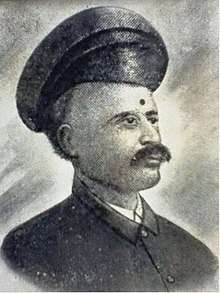Shivkar Bapuji Talpade
Shivkar Bāpuji Talpade (1864 – 1916)[1] was an Indian scholar who some reports say constructed the first unmanned airplane in 1895. Talpade lived in Mumbai and studied Sanskrit literature and the Vedas.
Shivkar Bapuji Talpade | |
|---|---|
 Shivkar Bapuji Talpade | |
| Born | 1864 Bombay (Now Mumbai), Bombay Presidency |
| Died | 1916 (aged 51–52) |
| Nationality | Indian |
| Education | Sir Jamsetjee Jeejebhoy School of Art |
Early life and inspiration
Talpade was born in the Chira Bazaar neighborhood of Mumbai, Maharashtra[1] in a Pathare Prabhu family.[2] He completed his school education in Sir Jamsetjee Jeejebhoy School of Art. During his time there he came to know about stories describing ancient Indian aeronautics through his teacher Chiranjilal Verma, who led Talpade to read Dayanand Saraswati's works related to ancient aeronautics, such as ‘Rigvedādic Bhāshya Bhumikā’ and ‘Rigved and Yajurveda Bhāshya’. However, some sources also suggests that his works were based on the work done by Maharishi Bharadwaja in the Rigveda.[3] Inspired by these texts he decided to construct the Vedic Vimāna described in the Vedas, and started learning Vedic Sanskrit language.
Pratap Velkar, the principal source for most information on Talpade,[2] says that Talpade also studied the achievements of aviation pioneers such as Thomas Alva Edison, who flew in a balloon, and machine gun inventor Hiram Maxim, who made a captive steam-driven aircraft. According to Velkar, Talpade studied these flights, which inspired him to make an aircraft and fly.[4] Some theories also state that he was inspired by the Vaimānika Shāstra which was said to be earlier orally transmitted from Rishi Bharadwaja to Pandit Subbaraya Shastry.[2]
Marutsakhā
Talpade's airplane was named Marutsakhā, derived from the Sanskrit Marut ('air' or 'stream') and sakhā ('friend') which together mean 'Friend of wind'. As suggested by D. K. Kanjilal's 1985 Vimana in Ancient India: Aeroplanes Or Flying Machines in Ancient India, Marutsakhā is supposed to have been inspired from Vimāna, ancient flying-machines in Hindu epics.[5] He states that the contemporary reports in the Marāthi-language newspaper Kesari attested to the purported flight, however the article on it was written only in 1952.[6]
Contemporary accounts of a successful flight or evidences of such an achievement are scarce and the technical feasibility is dubious. The technical basis of the Vedic Ion Design which was supposedly used by Talpade has been debunked by research into the technological feasibility of such flights.[3] Various versions suggest he used a kind of urine or mercury as fuel.[6][2]
One of Talpade's students, Pt. S. D. Satawlekar, wrote that Marutsakhā sustained flight for a few minutes.[7] According to K.R.N. Swamy "a curious scholarly audience headed by a famous Indian judge and a nationalist, Mahadeva Govinda Ranade and H H Sayaji Rao Gaekwad, respectively, had the good fortune to see the unmanned aircraft named as ‘Marutsakthi’ take off, fly to a height of 1500 feet and then fall down to earth".[1] Mahadev Govind Ranade and Sayajirao Gaekwad III were also said to be present during the flight test.[8] Pratap Velkar in "Maharashtracha Ujwal Itihaas" however contradictes such claims, stating that "It wasn't a well-publicized event. It was more like a sporting event. Apart from a few curious onlookers, the only people present were some friends who had showed up to watch him."[7]
Moreover, Valjar states that Marutsakhā was apparently a cylindrical structure made of bamboo and filled with liquid mercury. The contraption was supposed to fly when the mercury reacts with sunlight to release hydrogen, which is lighter than air. But, according to Velkar, the plane did not get very high or stay up too long; it rose to a small height and crashed within minutes. A former Indian defense scientific officer, D. H. Bedekar, stated in 2004 that Marutsakhā failed to operate to its full design limits due to technical reasons.[7]
After the experiment, Marutsakhā apparently was stored at Talpade's house until well after his death. Velakara quotes one of Talpade's nieces, Roshan Talpade, as saying the family used to sit in the aircraft's frame and imagine they were flying. There are various versions of where the plans went—according to one it was taken by Rallis Brothers, which is owned by Tata Sons, or Hindustan Aeronautics Limited.[2] Talpade's documents were taken by G. H. Bedekar, who worked with the Ministry of Defence and some passed on to HAL, though the aviation historian Anuraddha Reddy was unable to find them.[6] Bedekar refused to share Talpade's documents but stated that they show that he was unsuccessful. The Vaimānika Shāstra states that he had tried to build an aircraft but was unsuccessful.[6]
Popular culture
A film based on life of Talpade, Hawaizaada, starring Ayushmann Khurrana, was released on 30 January 2015. The film was earlier titled Bambai Fairytale.
See also
References
- "Flying high". Deccan Herald. 16 December 2003. Archived from the original on 11 February 2015. Retrieved 3 February 2015.
- Lhendup G Bhutia (30 January 2015). "The Myth of the Indian Aviator". OPEN Magazine.
Talpade is believed to have been born in 1864 in the Pathare Prabhu community in a South Mumbai home
Cite magazine requires|magazine=(help) - H.S. Mukunda; S.M. Deshpande; H.R. Nagendra; A. Prabhu; S.P. Govindraju (1974). "A critical study of the work "Vyamanika Shastra"" (PDF). Scientific Opinion: 5–12. Retrieved 3 September 2007.
- Desmond, Kevin (2018). Electric Airplanes and Drones: A History. McFarland. ISBN 978-1-4766-6961-8.
- Pratāpa Velakara, Pāṭhāre prabhūñcā itihāsa: nāmavanta lekhakāñcyā sas̃́odhanātmaka likhāṇāsaha : rise of Bombay from a fishing village to a flourishing town, Pune, Śrīvidyā Prakāśana (1997)
- Ganesan, Ranjita (14 January 2015). "Shivkar Talpade: First man to fly an aircraft?". Rediff.
- Pradeep Vijayakar (18 October 2004). "A flight over Chowpatty that made history". The Times of India. Retrieved 3 February 2015.
- Annals of the Bhandarkar Oriental Research Institute, Volume 69. The Institute. 1989. p. 365. JSTOR i40079502.